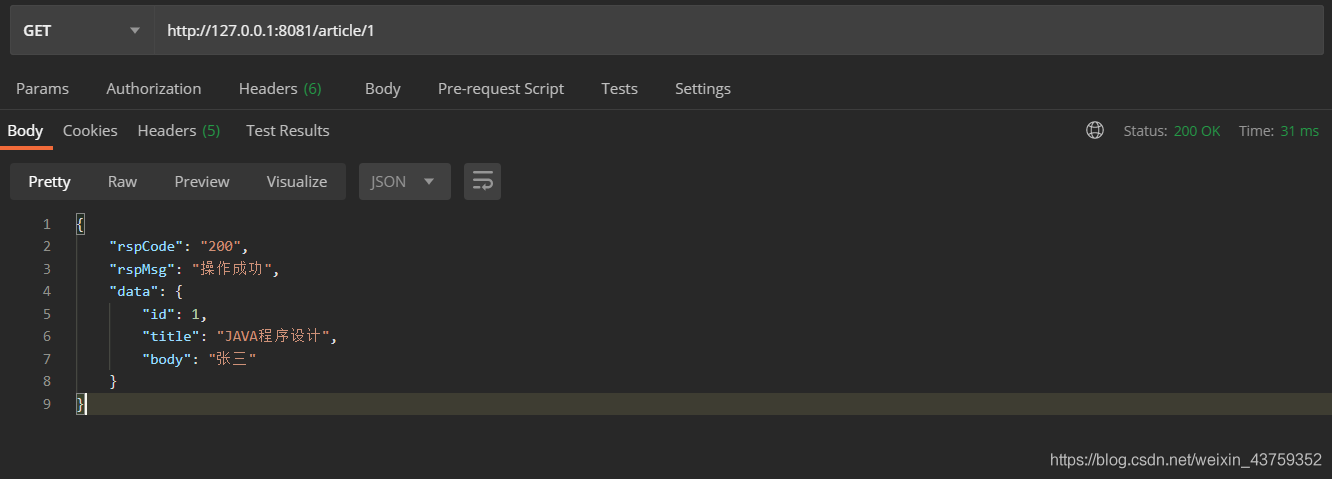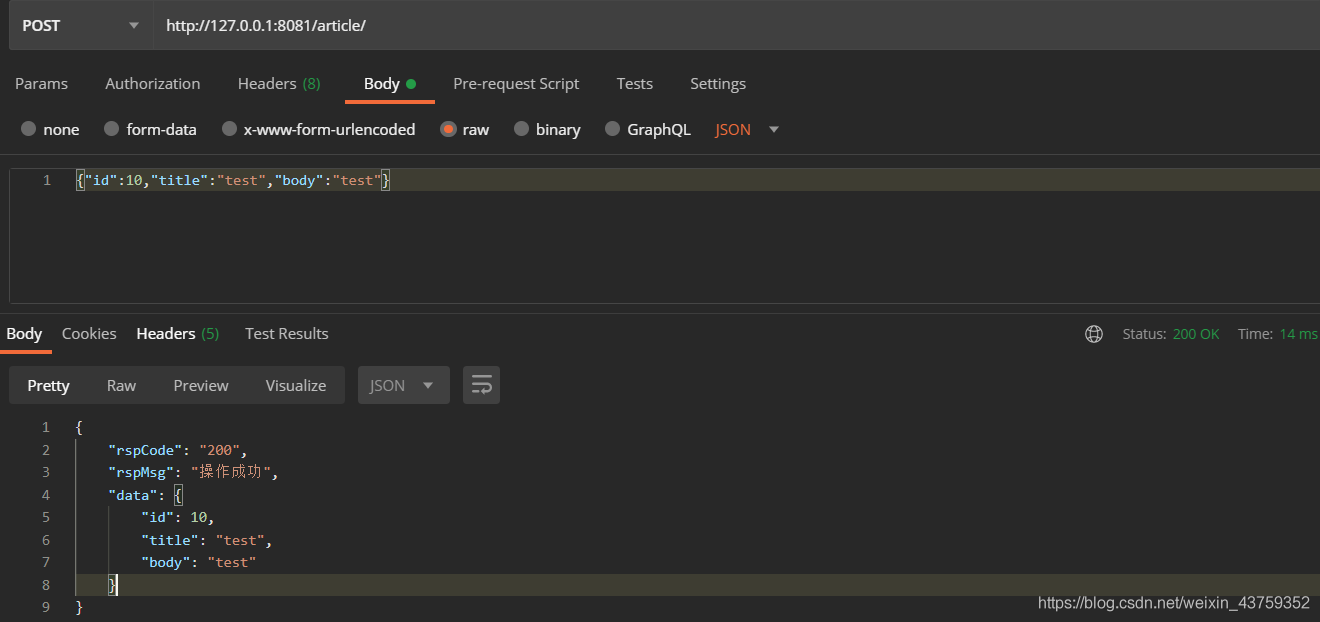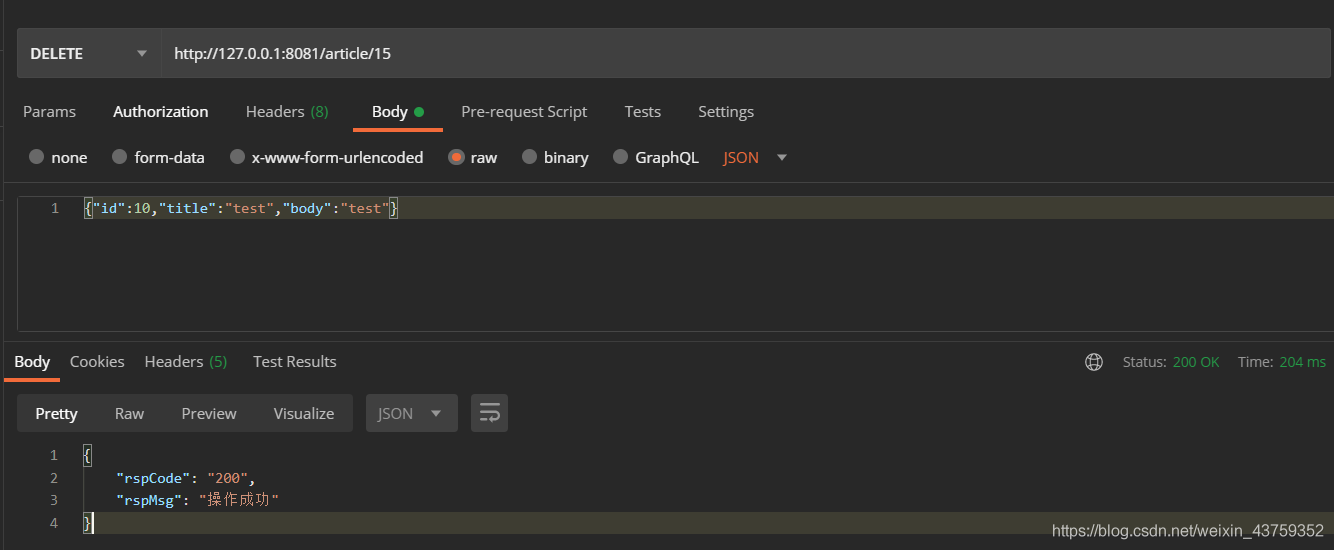SpringBoot總結(十五)——介面架構風格(RESTful)
【第一部分】歷史文章:
SpringBoot總結(一)——第一個SpringBoot專案
SpringBoot總結(二)——Spring Boot的自動設定
SpringBoot總結(三)——SpringBoot的組態檔
SpringBoot總結(四)——@Value和@ConfigurationProperties的區別
SpringBoot總結(五)——@PropertySource註解與@ImportResource註解
SpringBoot總結(六)——SpringBoot組態檔預留位置
SpringBoot總結(七)——Profile的使用
SpringBoot總結(八)——組態檔的載入位置
SpringBoot總結(九)——@Conditional註解與自動設定報告
SpringBoot總結(十)——SpringBoot+Mybatis實現資料庫的CRUD(從建立到實現【超詳細附程式碼】)
SpringBoot總結(十一)——SpringBoot的靜態資源對映規則
SpringBoot總結(十二)——登入介面的實現
SpringBoot總結(十三)——修改嵌入式Servlet容器設定
SpringBoot總結(十四)——SpringBoot整合JDBCTemplate及Druid連線池
介面架構風格(RESTful)
文章目錄
前言
本篇文章主要介紹了RESTful的一些知識點,以及基於RESTful風格的CRUD的例子,和基於SpringBoot為手機APP、PC、構建統一風格的Restful API。
一、什麼是REST
REST是軟體架構的規範體系結構,它將資源的狀態以適合使用者端的形式從伺服器端傳送到使用者端(或者相反的方向)。在REST中,通過URL進行資源定位,用HTTP動作(GET、POST、DELETE、PUT等)描述操作完成功能。
遵循RESTful風格,可以使得開發的介面通用,以便呼叫者理解介面的作用。因此,基於REST構建的API就是RESTful(REST風格)API。
各大機構提供的API基本都是RESTful風格的。這樣可以統一規範,減少溝通,學習和開發的成本。
二、HTTP動作與CRUD動作對映
RESTful風格使用同一個URL,通過約定不同的HTTP方法來實施不同的業務。
下面是普通網頁的CRUD和RESTful風格的CRUD的區別:
| 動作 | 普通CRUD的URL | 普通CRUD的HTTP方法 | ReSTful的URL | RESTful的CRUD的HTTP方法 |
|---|---|---|---|---|
| 查詢 | Article/id=1 | GET | Article/{id} | GET |
| 新增 | Article?title=xxx&body=xxx | GET/POST | Article | POST |
| 修改 | Article/update?id=xxx | GET | Article/{id} | PUT或者PATCH |
| 刪除 | Article/delete?id=xxx | GET | Article/{id} | DELETE |
三、基於RESTful風格的CRUD例子
3.1、主要程式碼
下面是基於RESTful風格的CRUD的例子,並且定義了統一的資料返回格式。
運算元據庫的方式採用了SpringBoot與SpringDataJPA整合的方式;具體這裡將不再詳細介紹,下面附上一些主要的程式碼。
ArticleController.java
package com.example.controller;
import com.example.entity.Article;
import com.example.repository.ArticleRepository;
import com.example.result.ExceptionMsg;
import com.example.result.Response;
import com.example.result.ResponseData;
import io.github.yedaxia.apidocs.ApiDoc;
import org.springframework.beans.factory.annotation.Autowired;
import org.springframework.web.bind.annotation.*;
import java.io.IOException;
import java.util.ArrayList;
import java.util.List;
/**
* 文章介面類
*/
@RequestMapping("/article")
@RestController
public class ArticleController {
protected Response result(ExceptionMsg msg){
return new Response(msg);
}
protected Response result(){
return new Response();
}
@Autowired
private ArticleRepository articleRepository;
/**
* 查詢所有文章
* @return
*/
@RequestMapping(value = "/", method = RequestMethod.GET)
public ResponseData getArticleList() {
List<Article> list = new ArrayList<Article>(articleRepository.findAll());
return new ResponseData(ExceptionMsg.SUCCESS,list);
}
/**
* 增加文章資訊
* @param article 文章物件
* @return
*/
@RequestMapping(value = "/", method = RequestMethod.POST)
public ResponseData add(@RequestBody Article article) {
articleRepository.save(article);
return new ResponseData(ExceptionMsg.SUCCESS,article);
}
/**
* 刪除文章資訊
* @param id 文章id
* @return Response
*/
@RequestMapping(value = "/{id}", method = RequestMethod.DELETE)
public Response delete(@PathVariable("id") int id) {
articleRepository.deleteById(id);
return result(ExceptionMsg.SUCCESS);
}
/**
* 修改文章資訊
* @param model 文章物件
* @return ResponseData
*/
@RequestMapping(value = "/{id}", method = RequestMethod.PUT)
public ResponseData update(@RequestBody Article model) {
articleRepository.save(model);
return new ResponseData(ExceptionMsg.SUCCESS,model);
}
/**
* 根據文章id 查詢文章資訊
* @param id
* @return ResponseData
* @throws IOException
*/
@RequestMapping(value = "/{id}", method = RequestMethod.GET)
public ResponseData findArticle(@PathVariable("id") int id) throws IOException {
Article article = articleRepository.findById(id);
if (article != null) {
return new ResponseData(ExceptionMsg.SUCCESS,article);
}
return new ResponseData(ExceptionMsg.FAILED,article);
}
}
3.2、測試資料
啟動專案,進行如下的測試。
- 查詢所有資料。用GET方法存取:http://127.0.0.1:8081/article/返回的結果如下:

- 查詢指定的資料。用GET方法存取:http://127.0.0.1:8081/article/1返回的結果如下:

- 新增資料。用POST方法存取:http://127.0.0.1:8081/article/返回的結果如下:

- 刪除資料。用DELETE方法存取:http://127.0.0.1:8081/article/15返回的結果如下:則代表刪除成功。

四、為手機APP、PC、H5網頁提供統一風格的API
4.1、實現響應的列舉類
package com.example.result;
//實現響應的列舉類
public enum ExceptionMsg {
SUCCESS("200", "操作成功"),
FAILED("999999","操作失敗"),
ParamError("000001", "引數錯誤!"),
FileEmpty("000400","上傳檔案為空"),
LimitPictureSize("000401","圖片大小必須小於2M"),
LimitPictureType("000402","圖片格式必須為'jpg'、'png'、'jpge'、'gif'、'bmp'")
;
private ExceptionMsg(String code, String msg) {
this.code = code;
this.msg = msg;
}
private String code;
private String msg;
public String getCode() {
return code;
}
public String getMsg() {
return msg;
}
}
4.2、實現返回的物件實體
package com.example.result;
/**
* @author 2017810402084
* 實現返回物件實體
*/
public class Response {
/** 返回資訊碼*/
private String rspCode="000000";
/** 返回資訊內容*/
private String rspMsg="操作成功";
public Response() {
}
public Response(ExceptionMsg msg){
this.rspCode=msg.getCode();
this.rspMsg=msg.getMsg();
}
public Response(String rspCode) {
this.rspCode = rspCode;
this.rspMsg = "";
}
public Response(String rspCode, String rspMsg) {
this.rspCode = rspCode;
this.rspMsg = rspMsg;
}
public String getRspCode() {
return rspCode;
}
public void setRspCode(String rspCode) {
this.rspCode = rspCode;
}
public String getRspMsg() {
return rspMsg;
}
public void setRspMsg(String rspMsg) {
this.rspMsg = rspMsg;
}
@Override
public String toString() {
return "Response{" +
"rspCode='" + rspCode + '\'' +
", rspMsg='" + rspMsg + '\'' +
'}';
}
}
4.3、封裝返回結果
package com.example.result;
import com.example.exception.BusinessException;
/**
* @author 2017810402084
* 返回結果資料格式封裝
*/
public class ResponseData extends Response {
private Object data;
public ResponseData() {
}
public ResponseData(Object data) {
this.data = data;
}
public ResponseData(ExceptionMsg msg) {
super(msg);
}
public ResponseData(String rspCode, String rspMsg) {
super(rspCode, rspMsg);
}
public ResponseData(String rspCode, String rspMsg, Object data) {
super(rspCode, rspMsg);
this.data = data;
}
public ResponseData(ExceptionMsg msg, Object data) {
super(msg);
this.data = data;
}
public Object getData() {
return data;
}
public void setData(Object data) {
this.data = data;
}
/**
* 自定義異常的返回結果
* @param de
* @return
*/
public static ResponseData defineBusinessException(BusinessException de) {
ResponseData responseData = new ResponseData();
responseData.setRspCode(de.getCode());
responseData.setRspMsg(de.getMsg());
responseData.setData(null);
return responseData;
}
}
4.4、統一處理異常
package com.example.exception;
import com.example.result.ResponseData;
import org.springframework.http.HttpStatus;
import org.springframework.web.bind.annotation.ExceptionHandler;
import org.springframework.web.bind.annotation.ResponseBody;
import org.springframework.web.bind.annotation.ResponseStatus;
import org.springframework.web.bind.annotation.RestControllerAdvice;
/**
* @author 2017810402084
* 定義全域性例外處理類:來處理各種的異常,包括自己定義的異常和內部的異常
*/
@RestControllerAdvice
public class GlobalExceptionHandler {
/**
* (1)處理自定義異常BusinessException
*/
@ExceptionHandler(value = BusinessException.class)
@ResponseBody
public ResponseData bizBusinessException(BusinessException e) {
return ResponseData.defineBusinessException(e);
}
/**
* (2)處理其他的異常
*/
@ExceptionHandler(value = Exception.class)
@ResponseBody
public ResponseData exceptionHandler(Exception e) {
return new ResponseData(e);
}
}
4.5、自定義異常
package com.example.exception;
/**
* @author 2017810402084
* 建立自定義例外處理類:BusinessException.java
*/
public class BusinessException extends RuntimeException{
private String code;
private String msg;
public BusinessException(String code, String msg) {
this.msg = msg;
this.code = code;
}
public String getCode() {
return code;
}
public void setCode(String code) {
this.code = code;
}
public String getMsg() {
return msg;
}
public void setMsg(String msg) {
this.msg = msg;
}
}
4.6、進行測試
package com.example.controller;
import com.example.exception.BusinessException;
import com.example.exception.UserNameNotMatchPasswordException;
import com.example.result.ResponseData;
import org.springframework.http.HttpStatus;
import org.springframework.web.bind.annotation.RequestMapping;
import org.springframework.web.bind.annotation.RequestParam;
import org.springframework.web.bind.annotation.ResponseStatus;
import org.springframework.web.bind.annotation.RestController;
/**
*
* 統一異常測試類
*/
@RestController
@RequestMapping("/test")
public class TestController {
/**
* 自定義異常測試
* @return
*/
@RequestMapping("/BusinessException")
public ResponseData DeException() {
throw new BusinessException("40000000", "出錯了!");
}
/**
* 處理其他的異常
* @return
*/
@RequestMapping("/getException")
public ResponseData Exception() {
ResponseData responseData = new ResponseData();
responseData.setRspCode("400");
responseData.setRspMsg("出錯");
return responseData;
}
}


總結
以上就是本篇所介紹的內容,以一個簡單的例子,來演示了基於RESTful風格的CRUD操作,以及構造統一風格的RESTful API。希望通過這個例子能給予大家幫助。😊關於本專案程式碼獲取方式:關注+私信並回復:【RESTful專案】即可獲取哦
